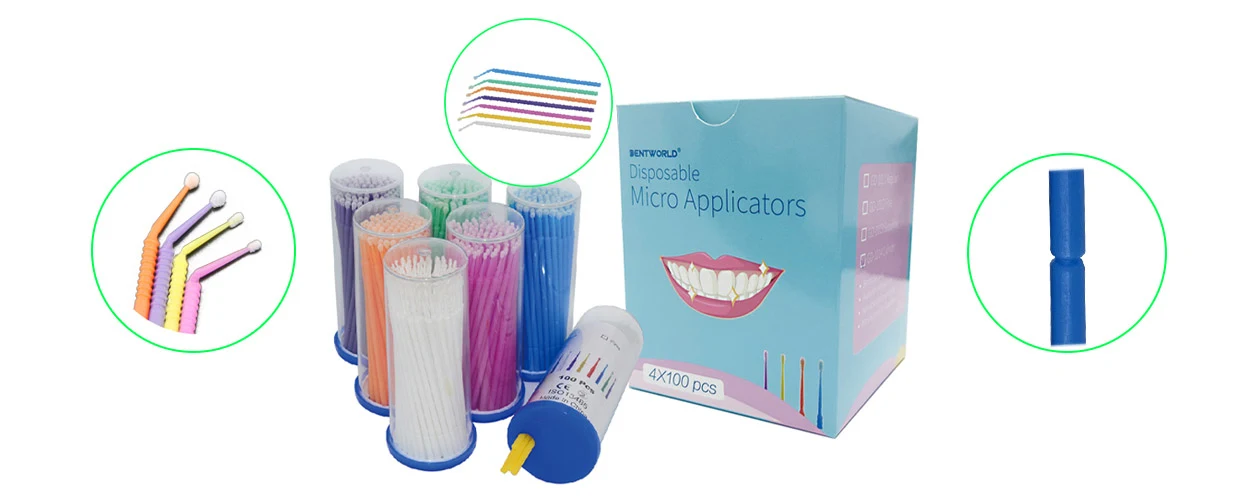Le pinceau micro-applicateur est un contrôlé microfluidique, Applicateur précis et flexible. Il est largement utilisé dans le médical, dentaire, soins personnels, Cosmétique et autres domaines. Dans cet article, Nous présenterons un pinceau micro applicateur à partir de plusieurs dimensions.
1. The Basic Definition of Micro Applicator Brush
UN pinceau de micro applicateur is small, slender and commonly used tools. It is usually composed of a soft brush head and a plastic rod body. The brush head is made of soft fiber materials such as polyester and nylon, and can precisely apply to specific areas. The shaft body is usually made of plastic, with a moderate length and weight to ensure the flexibility and comfort of operation. Disposable application sticks are discarded after use and can effectively prevent cross-infection problems. Donc, they are widely used in places with high hygiene requirements, such as medical, dental and beauty care.
2. Structure du pinceau micro-applicateur
The structure of disposable applicator brush mainly consists of two parts:
- Brush head (head) : The brush head part is the core component of the disposable applicator brush, usually made of synthetic chemical fibers (such as nylon, polyester, polyuréthane, etc.), and has good flexibility and adsorption. The tiny brush head can be used for local medication application, nettoyage des plaies, eye care, etc.. To meet different needs, the applicator brushes are classified into various models based on the density and length of the bristles. You can choose according to your specific requirements to ensure that the medicine or treatment agent can be evenly applied to the target area. Some high-end models adopt a 50μm grade ultrafine fiber matrix (with a density of 2000 fibers per cm²) to achieve precise control of 0.01ml of drug.
- The stem (handle) : The stem is usually made of polypropylène de qualité médicale to ensure its lightness and sturdiness. In terms of the design of the rod body, anti-slip textures will be added to enhance the stability of operation. The upper part of the rod end can be bent to adapt to the complex environment of the oral cavity, and the lower part can be broken to adjust the length.

Micro Applicator Brush vs Cotton Smap:
| Produit | Coton-coton | Pinceau de micro applicateur |
| Précision de revêtement | ± 1,2 mm | ± 0,05 mm |
| Capacité de transport en médicament | 0.1ml | 0.01ml |
| Utilisation des matériaux | 38± 5% | 89± 3% |
3. Zones d'application du pinceau micro applicateur
Domaine médical:
En tant qu'outil de livraison de médicaments précis, Les pinceaux micro-applicateurs sont d'une grande valeur dans la pratique clinique. Sa conception aseptique permet une mise en œuvre précise des soins des plaies, Désinfection des plaies et opérations de distribution de médicaments pour le canal oculaire / oreille, éviter efficacement la contamination croisée des médicaments. Tout en réalisant le contrôle de la dose de médicament, Conformément aux exigences de prévention et de contrôle dans les soins médicaux modernes.
Application dentaire:
En traitement oral, La brosse à micro applicateur est principalement utilisée dans le revêtement de fluorure, Administration du gel antibactérien et traitement parodontal. Sa conception de poignée mince vous permet de terminer facilement des opérations délicates telles que le traitement de la surface dentaire et la livraison de médicaments à marge gingivale dans l'espace oral restreint. Ce qui améliore considérablement l'efficacité du traitement et le confort des patients.
Champ de beauté:
Dans le domaine du maquillage de la belle beauté, Ce produit peut réaliser des opérations de maquillage de niveau millimétrique telles que la contribution des eye-liner et la modification des lèvres. L'élasticité du gradient de la conception de la tête afflux peut assurer l'extension uniforme des cosmétiques. Mais aussi pour éviter la stimulation mécanique des zones sensibles. Dans le domaine des soins de la peau, Il peut contrôler avec précision la quantité d'essence de masque et de solution de soins oculaires appliquée et de réduire les déchets de produits.
Industrie du tatouage:
Le pinceau Micro Applicator joue un rôle important dans l'ensemble du processus de tatouage: il est utilisé pour stériliser la peau locale avant l'opération, pour appliquer une pommade antibactérienne pendant l'opération, et pour administrer précisément la crème réparatrice après l'opération. Ses propriétés de microdosage maintiennent un environnement humide sur la surface traumatisée, promouvoir la régénération et la pigmentation épidermiques. Par rapport à l'application des doigts traditionnels, il peut réduire plus le coefficient de frottement du traumatisme 60%. Avec l'emballage aseptique jetable, il garantit que l'outil est propre et stérile à chaque fois qu'il est utilisé, qui améliore la norme d'hygiène.
Recherche expérimentale:
Dans les scénarios de laboratoire biologique, Le pinceau micro-applicateur stérilisé gamma convient aux opérations telles que les taches micro-réagies, étalage de plaque d'agar et transfert de déformation. Sa tête de brosse en fibre de polyester a de faibles caractéristiques d'adsorption des protéines, qui garantit la fiabilité des expériences de culture cellulaire, et démontre des avantages techniques uniques dans la préparation des échantillons de PCR, Coloration des sections de tissus et autres processus.
Soins médicaux pour animaux de compagnie:
Pour les animaux de compagnie comme les chiens et les chats, Sa conception de la tête de brosse douce peut prévenir efficacement des dommages accidentels au conduit auditif / cornée, et avec l'amélioration de la palatabilité de la base de pommade, Il réduit considérablement la réaction de stress de l'animal pendant le traitement, qui a été de plus en plus largement utilisé dans le traitement des dermatoses fongiques, acariens et autres scénarios.

4. Analyse des tendances du marché des brosses micro-applicateurs
Le marché mondial des brosses micro-applicateurs est témoin d'une croissance structurée, tiré par l'augmentation continue de la sensibilisation à l'hygiène publique, superposé le renforcement des pratiques aseptiques dans le secteur de l'esthétique médicale / médicale. Les tendances centrales se manifestent comme:
Innovation matérielle durable
- The utilization rate of degradable materials reached 24% (data from 2023), and the production capacity of bio-based PLA/PHA composites increased by 300% over the past three years
- Itération du processus de production: Injection molding energy consumption is reduced by 35%, and the coverage rate of the water circulation system is increased to 78%
- The market share of EU EN 13432 certified products has exceeded 41%
Mise à niveau de la conformité médicale
- The sterilization standard has shifted to a dual certification system of EO ethylene oxide and gamma rays
- Biocompatibility testing has added ISO 10993-5 cytotoxicité et ISO 10993-10 allergenicity risk assessment
- The damage rate of aseptic packaging for medical products in 2024 should be ≤0.3%
Scene Customization Explosion
- Morphological adaptability design: Patented models such as 0.8mm conical brush heads for ophthalmology and 15° curved handles for dentistry account for 37%
- Innovation in drug carriers: Thermosensitive hydrogel coatings (responding to phase transitions at 32-37 ° C) account for 52% du marché de la personnalisation dentaire
- Revêtements fonctionnels: The growth rate of silver-loaded antibacterial products has reached a CAGR of 29%
Perouilles de la technologie de base
- The R&D intensity of leading enterprises is 9.2% : The focus is on nano-scale drug sustained-release coatings (controlled-release accuracy ±5μg) and ultrafine fiber matrices (porosity 92%±3%)
- Dans 2024, the number of patent authorizations of the TOP5 manufacturers increased by 67% en glissement annuel, among which 3D printing one-piece molding technology accounted for 38%
The Global Layout Accelerates
- Emerging market drivers: The CAGR in the Asia-Pacific region is 18.7% (2025-2030), with demand in ASEAN countries such as Indonesia and Vietnam surging by 42%
- Supply chain restructuring: The local productivity of North American manufacturers has increased to 61%, and the cost of sea transportation has dropped by 19%.

5. Apprenez-vous à choisir un micro-applicateur Brush
When choosing disposable micro applicator brush, the following core indicators can be referred to:
- Material and structural compatibility: Select appropriate materials and designs based on the intended use. Par exemple, if you are a dental clinic, you can choose a brush head that can be bent and a rod that can be broken to adjust its length. It can better adapt to the narrow and complex environment inside the mouth. For beauty or makeup purposes, soft bristles with stronger adhesion are more important.
- Hygiene requirements: Medical-grade products must meet the ISO 11135 Stérilisation d'oxyde d'éthylène ou ISO 11137 Normes de stérilisation d'irradiation, with a sterility assurance level of SAL≤10⁻⁶, a biological load test report (initial contamination bacteria ≤100 CFU/g), and cytotoxicity tests that comply with ISO 10993-5 Class 2 contact requirements.
- Certification et conformité: Ensure that the coating stick complies with ISO 13485, FDA, CE or your local certification requirements. These certifications can ensure the compliance of products in terms of quality, hygiène, safety and other aspects.
- Emballage et stockage: Emballage principal: Medical dialysis paper/plastic composite film (conforming to ISO 11607 sealing integrity test), protection secondaire: tamper proof designed HDPE tank (passing ISTA 2A transportation test), conditions de stockage: Clean area with temperature of 10-30℃ and humidity of ≤65%RH.
6. Conclusion
Disposable micro applicator brush have formed a cross-field application matrix: in the medical field, they meet the drug administration needs of Class I/II wounds; in the medical aesthetics industry, they are suitable for the precise application of micro-drop drug solutions, and have been extended to scenarios such as laboratory sample preparation. Selon la recherche Grand View 2023 rapport, the annual growth rate of global market segmentation scenarios reached 7.2%-14.5%. Driven by the continuous improvement of the public’s requirements for hygiene, Sécurité et protection de l'environnement, the design of coating rods is also constantly innovating. The current iteration direction focuses on: degradable PLA composite materials, low-allergenic silicone brush heads (Certifié USP Classe VI), and antibacterial coating technology (silver ion load ≥0.5μg/cm²). À l'avenir, with the development of technology and changes in consumer demands, disposable micro applicator brushes will undergo more improvements and innovations, becoming more convenient, safe and environmentally friendly tools.


